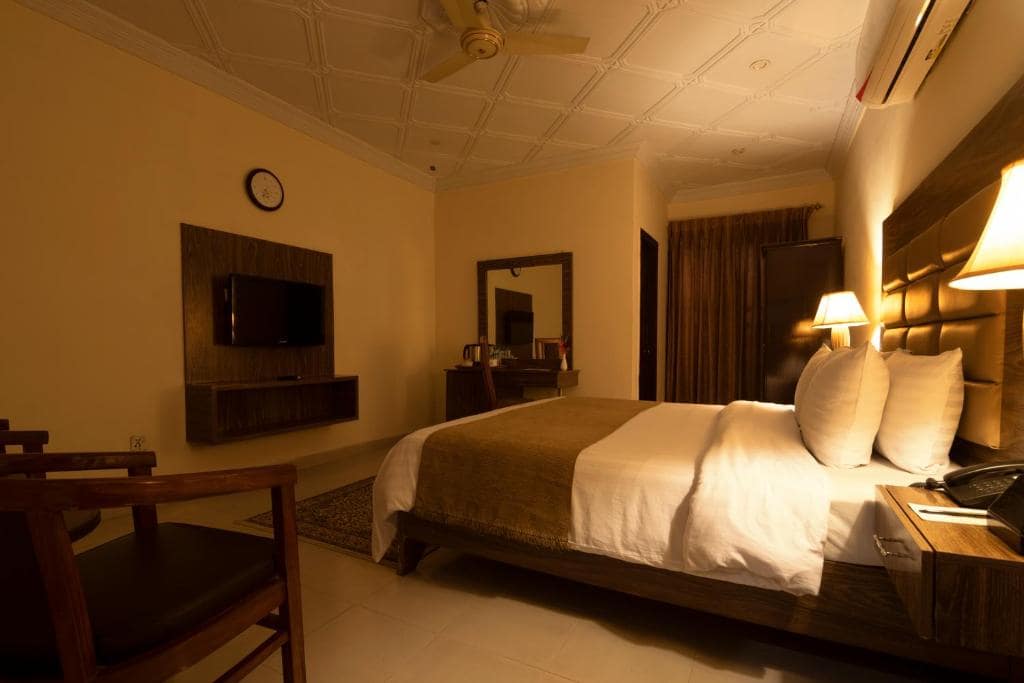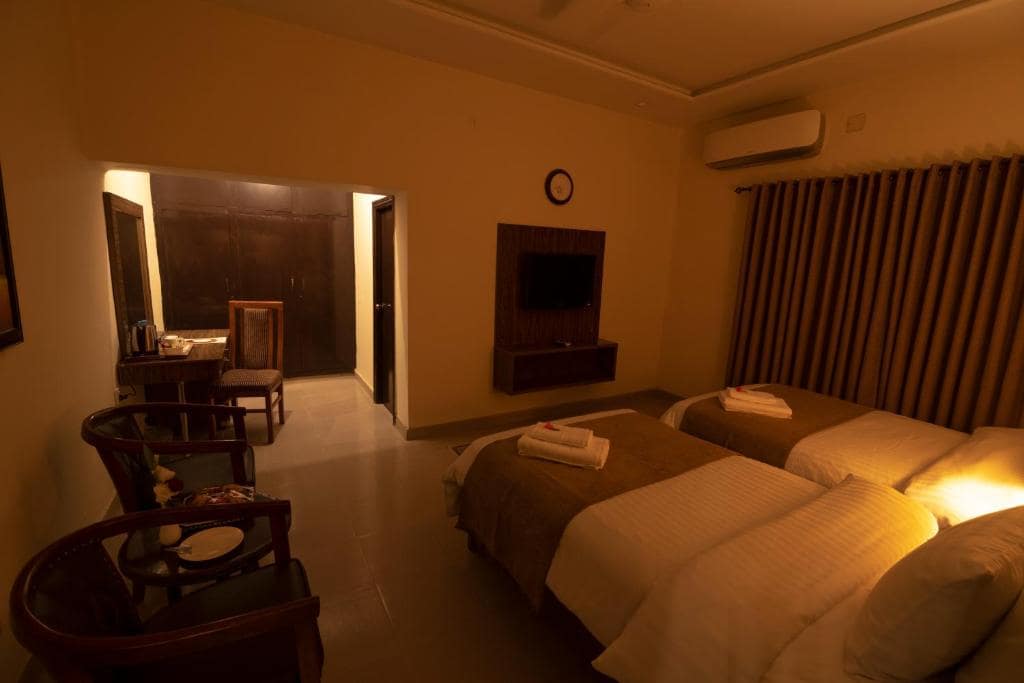General
Hotel One is located at Lalazar Colony Multan. The hotel features a fitness center, a business center, and free parking. The 24-hour front desk offers complimentary daily newspapers. All of the air-conditioned rooms feature a flat-screen television, a coffee maker, and a minibar. The en suite bathrooms feature a shower and complimentary toiletries. The Fortalice Multan is located 7 kilometers from the Clock Tower and 10 kilometers from the local shrines. It is 110 kilometers away from Bahawalpur. Guests can play table tennis or rent a car to explore the surrounding area.
Check-in
From 2:00 pm
Check-out
Untill 12:00 pm
Cancellation / Prepayment
Cancellation and prepayment policies vary according to room type. Please check the room conditions when selecting your room.
Payment Options
Bank Transfers & Online Payment options available in the following bank account.
- Account Title: Fly Pakistan
Facilities
Outdoors
- Garden
Food & Drink
- Bar
- Bottle of water
- Breakfast in the room
- Restaurant
Internet
- WiFi is available in all areas and is free of charge.
Reception services
- 24-hour front desk
- Currency exchange
- Lockers
- Luggage storage
- Private check-in/check-out
Cleaning services
- Daily housekeeping
- Ironing service
Business facilities
- Business centre
- Fax/photocopying
- Meeting/banquet facilities
General
- 24-hour security
- CCTV in common areas
- CCTV outside property
- Fire extinguishers
- Safety deposit box
- Security alarm
- Smoke alarms
Safety & security
- Air conditioning
- Designated smoking area
- Family rooms
- Newspapers
- Non-smoking rooms
- VIP room facilities
Languages spoken
- English
- Urdu
This Hotel One Lalazar Colony's Map Location is not Available yet,
For more details Please contact FlyPakistan 24/7 Customer Care Service +92 345 9668442.
Map View of Hotel One Lalazar Colony
Hotel Score and Score Breakdown
Based on 782 reviews
Guest reviews are written by our customers after their stay at Hotel Hotel One Lalazar Colony
- Clean
- 8
- Comfort
- 6
- Location
- 8
- Staff
- 10
- Services
- 7
- Value for money
- 9
Guest reviews
-

Hello World! https://racetrack.top/go/giywczjtmm5dinbs?hs=ebd5f1ecd82ebadff66ebf6a11d288aa&
ayfkuh@tofeat.com
2023-04-110/ 10 4d5vs7
fgcmwn
Tomb Of Shah Yusuf Gardezi
Alang Bohar Gate, Inner City, Multan • Show on map
Shah Yousuf Gardez was an Islamic Sufi saint who came to Multan, (present-day Punjab, Pakistan) in 1088 AD.
Shah Yousuf Gardez was an Islamic Sufi saint who came to Multan, (present-day Punjab, Pakistan) in 1088 AD. He is said to have restored the city of Multan, converted many people to the Islamic religion, and performed numerous miracles. He came from Gardez in the present-day Paktia Province of Afghanistan.
Tomb Shah Shams Sabzwari Tabrez
Baba Safra Rd, Basti Bawa Safra, Multan • Show on map
Shamsuddin Sabzwari arrived in Multan in early 1200C.E. in modern Pakistan, established a dargah and preached Islam to the local population.
Shamsuddin Sabzwari arrived in Multan in early 1200C.E. in modern Pakistan, established a dargah and preached Islam to the local population. Shamsuddin Sabzwari is considered to be a saint due to his poetry and the local traditions. Shamsuddin Sabzwari died in 1276 and his mausoleum is located in Multan. The Urs of Shamsuddin Sabzwari takes place June of each year.[3] In South Asia, by the propagation of Islam commenced after the demise of Mohammad and Sindh was first to receive Islam. At about the same time, the followers and well wishers of Muhammad's family had started preaching and conversion on behalf of Ali and his successive Imams.
Tomb Shah Rukne Alam
Qilla Kohna, Qila Kohna Qasim Bagh Rd, Multan • Show on map
Shah Rukne Alam was the son of Pir Sadar-Al-Din Arif. He was born in Multan on 26 November 1251 and died 3 January 1335.
Shah Rukne Alam was the son of Pir Sadar-Al-Din Arif. He was born in Multan on 26 November 1251 and died 3 January 1335. He was the grandson and successor of Sheikh Baha-ud-din Zakariya. He was buried in the mausoleum of his grandfather, according to his own willbut later, his coffin was transferred to the present mausoleum. Shah Rukn-e-Alam conferred his spiritual succession on Sufi sheikh Sultan Ul Tareeqin Sheikh Hameed ud Din Shah Hakim Al-Qureshi Asadi Al-Hashmi Suhrawardi. He is buried at Mau Mubarak in Rahim Yar Khan. He was Shah Rukn e Alam's Ataleeq-e-Awwal, Khalifa-e-Awwal and was married to the daughter of Sheikh Baha-ud-Din Zakariya.
Fort Kohna Qasim Garden
Hussain Agahi Rd, Qila Kuhna Qasim Bagh, Multan • Show on map
Multan is a Historical city. Its History spread on centuries. Multan is Also Known as the city of “Garma, Gard, Gada and Goristan”.
Multan is a Historical city. Its History spread on centuries. Multan is Also Known as the city of “Garma, Gard, Gada and Goristan”. Multan fort is situated in the center of city. Multan Fort was built on a mound separating it from the city by the old bed of river Ravi. Its date cannot be fixed with accuracy. Apart from the shrines, most of the fort was destroyed by the British in 1848-49 to avenge the death of Lieutenant Alexander vans Agnew, killed in Multan by order of the Sikh governor. Agnew's memorial obelisk stands on a plinth at one of the highest points of the fort mound. A panoramic view of Multan City can be had from the highest point in the fort. The Fort was originally known as Katochgarh and is attributed to have been built by the Katoch Dynasty.
Shrine Of Bahauddin Zakriya
Prahladpuri Temple، Qilla Kohna Qasim Bagh Rd, Multan • Show on map
By the 13th century, the belief that the spiritual powers of great Sufi saints were attached to their burial sites was widespread in the Muslim world1
The shrine was built in 1262 before the death of Zakariya in 1268. Unusual for a dervish, the structure was paid for at the expense of Bahauddin Zakariya - highlighting his unique financial independence. Dara Shikoh unsuccessfully attempted to win the loyalty of Multan's citizens by donating 25,000 Rupees to the shrine following his defeat by his brother at the Battle of Samugarh in 1658. The shrine's sajjada nashin, or hereditary caretaker, Makhdoom Mahmud assisted British forces against Sikh forces during the Siege of Multan in 1848. The shrine's cupola and part of its upper tier were damaged during the siege by British cannonballs, but were repaired soon afterwards.


















